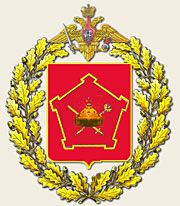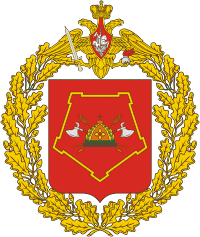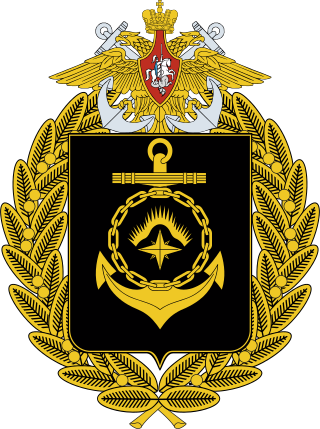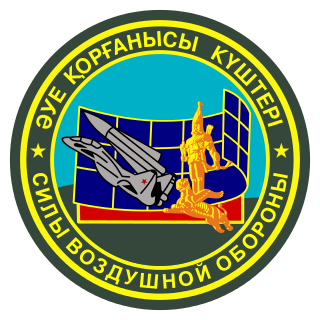Related Research Articles

The Russian Naval Infantry, often referred to as Russian Marines in the West, operate as the naval infantry of the Russian Navy. Established in 1705, they are capable of conducting amphibious operations as well as operating as more traditional light infantry.
The Northern Front was a front of the Red Army during the Second World War.
A mechanised corps was a Soviet armoured formation used prior to the beginning of World War II and reintroduced during the war, in 1942.

The 2nd Guards Tatsinskaya Tank Corps was a tank corps of the Soviet Union's Red Army that saw service during World War II on the Eastern Front of Europe. The unit's most notable moment was in the raid on Tatsinskaya during Operation Little Saturn in World War II. After the war, it continued to serve with the Soviet occupation forces in Central Europe. It was originally the 24th Tank Corps. The formation had approximately the same size and combat power as a Wehrmacht Panzer Division, and less than a British Armoured Division had during World War II.

The Russian 201st Military Base is a Russian military base based in Dushanbe, Tajikistan, part of the Central Military District. It was originally raised twice in World War II as part of the Soviet Union's Red Army and is now part of the Russian Ground Forces.

The Order of Lenin Moscow Military District was a military district of the Soviet Armed Forces and the Armed Forces of the Russian Federation. The district was awarded the Order of Lenin in 1968. In 2010 it was merged with the Leningrad Military District, the Northern Fleet and the Baltic Fleet to form the new Western Military District.

The Siberian Military District was a Military district of the Russian Ground Forces. The district was originally formed as a military district of the Russian Empire in 1864. In 1924 it was reformed in the Red Army. After the end of World War II the district was split into the Western and Eastern Siberian Military Districts. In 1956 the district was reformed. In 2010 it was divided between the two newly formed Central and Eastern Military Districts.

The 10th Guards Uralsko-Lvovskaya Volunteer Tank Division, also known as the Ural-Lvov Tank Division, is a tank division of the Russian Ground Forces and part of the Moscow Military District's 20th Guards Army. The division traces its heritage back to 1943, during World War II. It is headquartered and based at Boguchar, 160 kilometres south of Voronezh, Voronezh Oblast.

The Soviet Airborne Forces or VDV was a separate troops branch of the Soviet Armed Forces. First formed before the Second World War, the force undertook two significant airborne operations and a number of smaller jumps during the war and for many years after 1945 was the largest airborne force in the world. The force was split after the dissolution of the Soviet Union, with the core becoming the Russian Airborne Forces, losing divisions to Belarus and Ukraine.
The Leningrad People's Militia Army was initially an all-volunteer formation of the Soviet Union raised during the Second World War for defense of Leningrad.

The 45th Guards Spetsnaz Detached Brigade is a special reconnaissance and special operations military unit of the Russian Airborne Troops, based near Moscow. It was formed in 1994 as the 45th Independent Spetsnaz Regiment, and expanded to a brigade in 2015.
The 1st Guards Proletariat Moscow-Minsk Order of Lenin, twice Red Banner Orders of Suvorov (II) and Kutuzov (II) Motor Rifle Division was a division of the Red Army and Russian Ground Forces active from c. 1918 to 2002.
The 15th Rifle Division was a military formation of the Red Army formed by renaming the Red Army's Inza Revolutionary Division on 30 April 1919. The division was active during the Russian Civil War and World War II.
The Order of Lenin Moscow Air Defence District was a formation of the Soviet Air Defence Forces and the Russian Air Defence Forces, which existed from 1954 to 1998, to fulfill the tasks of anti-aircraft defense of administrative and economic facilities. The district administration was in Moscow.

The Northern Fleet Joint Strategic Command, is one of the five military districts of the Russian Armed Forces, with its jurisdiction primarily within the northern region of European Russia and the Arctic Ocean.

The Red Banner Central Asian Military District was a military district of the Soviet Armed Forces, which existed in 1926–1945 and 1969–1989, with its headquarters at Tashkent (1926–1945) and Almaty (1969–1989). By USSR Order No.304 of 4 June 1926, the Turkestan Front was renamed the Central Asian Military District.
The 38th Guards Airborne Corps was an airborne corps of the Soviet airborne. It was activated during World War II in August 1944 and became a rifle corps in December of that year. The corps fought in the Vienna Offensive and the Prague Offensive during the spring of 1945. After the end of the war, it was converted back into an airborne corps. The corps served at Tula until its 1955 disbandment when the Soviet airborne was reorganized.
The following is a hierarchical outline for the Bulgarian People's Army at the end of the Cold War. It is intended to convey the connections and relationships between units and formations. At the end of the Cold War in 1989, the Bulgarian People's Army (BPA) reported to the Ministry of People's Defence (Bulgaria). The BPA included the Bulgarian Land Forces; the Air and Air Defence Forces; Navy; and Construction Troops.

The Kazakh Air Defense Forces is the aviation warfare branch of the Armed Forces of the Republic of Kazakhstan. Their responsibilities include protecting Kazakh airspace, as well as combat missions in support of other branches of the armed forces. The official holiday of the air forces is Aviation Day on August 18.
The 367th Rifle Division was raised in 1941 as a standard Red Army rifle division, and served for the duration of the Great Patriotic War in that role. It began forming in August 1941 in the Chelyabinsk Oblast. After forming, it was initially assigned to the 28th (Reserve) Army, but was soon reassigned to Karelian Front, where it remained until nearly the end of 1944. The division had mostly a relatively quiet war on this defensive front, but later saw action against the German forces trying to hold northern Finland, being awarded the Order of the Red Banner for its services. The division ended the war in 14th Separate Army on garrison duties in the far north.
References
Citations
- ↑ Dvoinykh, Kariaeva, Stegantsev, eds. 1993, p. 32.
- ↑ "17th Rifle Corps". The Luftwaffe, 1933–45. Retrieved 2019-08-27.
- ↑ Glantz 2005, p. 15.
- ↑ Glantz 2005, p. 18.
- ↑ Glantz 2005, p. 21.
- ↑ Glantz 2005, p. 25.
- ↑ Glantz 2005, p. 33.
- ↑ Glantz 2003, pp. 248–249.
- ↑ Glantz 2003, p. 250.
- ↑ Glantz 2003, pp. 251–253.
- ↑ Feskov et al 2013, p. 577.
- ↑ Feskov et al 2013, pp. 163–164.
- 1 2 3 4 Feskov et al 2013, pp. 555–556.
- ↑ Feskov et al 2013, p. 540.
- ↑ Feskov et al 2013, pp. 555.
- 1 2 Main Personnel Directorate of the Ministry of Defense of the Soviet Union 1964, p. 14.
- ↑ Tsapayev & Goremykin 2015, pp. 975–977.
Bibliography
- Dvoinykh, L.V.; Kariaeva, T.F.; Stegantsev, M.V., eds. (1993). Центральный государственный архив Советской армии [Central State Archive of the Soviet Army] (in Russian). Vol. 2. Minneapolis: Eastview Publications. ISBN 1-879944-03-0. Archived from the original on 2016-12-03. Retrieved 2017-05-25.
- Feskov, V.I.; Golikov, V.I.; Kalashnikov, K.A.; Slugin, S.A. (2013). Вооруженные силы СССР после Второй Мировой войны: от Красной Армии к Советской[The Armed Forces of the USSR after World War II: From the Red Army to the Soviet: Part 1 Land Forces] (in Russian). Tomsk: Scientific and Technical Literature Publishing. ISBN 9785895035306.
- Glantz, David (2003). The Soviet Strategic Offensive in Manchuria, 1945: 'August Storm'. Routledge. ISBN 1-135-77498-6.
- Glantz, David M. (2005). Soviet Operational and Tactical Combat in Manchuria, 1945: August Storm. Taylor & Francis e-Library. ISBN 0-203-49625-6.
- Main Personnel Directorate of the Ministry of Defense of the Soviet Union (1964). Командование корпусного и дивизионного звена советских вооруженных сил периода Великой Отечественной войны 1941–1945 гг[Commanders of Corps and Divisions in the Great Patriotic War, 1941–1945] (in Russian). Moscow: Frunze Military Academy.
- Tsapayev, D.A.; et al. (2015). Великая Отечественная: Комдивы. Военный биографический словарь[The Great Patriotic War: Division Commanders. Military Biographical Dictionary] (in Russian). Vol. 4. Moscow: Kuchkovo Pole. ISBN 978-5-9950-0602-2.